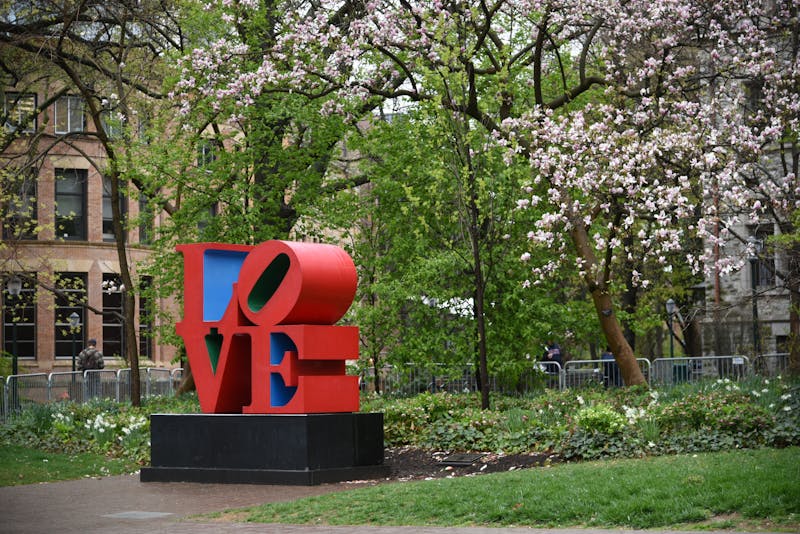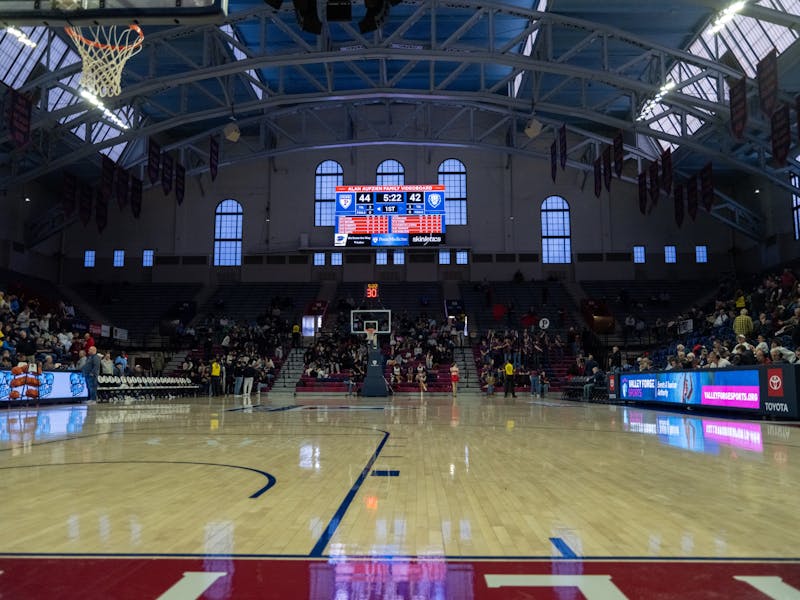Senior societies are all about big names - big-name leaders on campus and their own big names scrawled all over Locust Walk.
With three of the oldest senior societies at Penn - the Sphinx Senior Society, the Friar Senior Society and the Mortar Board Senior Honor Society - admitting their new classes this past week, each claims to have snatched up the best and brightest campus leaders around.
These Sphinges, Friars and Mortar Boards who cover our sidewalks with chalk every spring and fall are class presidents, chairs of performing arts groups and team captains. They are the powerhouses of the senior class, and they are making their mark on campus - literally.
Proctors and Presidents
Sphinx was founded in 1900 by a group of undergraduates with the purpose of upholding Penn traditions, said College senior and Chief of Sphinx Sarah Abroms. They served as unofficial advisors to the administration, proctoring tests, supervising class elections and orienting freshmen.
As official agencies assumed these duties, Sphinx became more of a social honor society for up-and-coming campus leaders. For example, the senior class president and the executive editor of The Daily Pennsylvanian have traditionally been Sphinges. This year's ranks also include the president of SPEC, the former Student Activities Council Chair and the former president of the InterFraternity Council.
Friars, formed to protest "caddishness and snobbery" at Penn, was first noted in the yearbook in 1901, the same year that Sphinx was first included, 1982 College graduate and friar Sally Katz said. Its membership traditionally includes leaders from the athletic, Greek and performing-arts communities. For example, the captains of the men's basketball team and the women's squash team are Friars, as are the former A capella Council chair and the chair of Bloomers.
Twenty years later, Mortar Board was formed initially as an all-female counterpart to Friars and Sphinx, which were originally all-male. Unlike its fellow senior societies, Mortar Board is part of a national organization that now has 223 chapters. Penn members include the chair of Strictly Funk, the executive vice president of Panhellenic Council and the captain of the baseball team.
While there is no formal oversight or umbrella organization tying them together, all three societies recognize that they represent a contingent of "major movers and shakers," as Abroms calls them, and the three host informal get-togethers and an annual senior society formal.
The Chosen Ones
Even though senior societies are clearly "selective" and "exclusive," said College senior and Abbot of Friars Tripper Sivick, they aren't intended to "pad resumes or be elitist."
Rather, their purpose is to "allow senior leaders to meet one another and get out of their own niches in Penn society," he explained.
Potential members must be "tapped" - selected by current members for consideration.
After searching "far and wide" for leaders to join their ranks, Friars sends out hand-delivered invitations to prospective members, inviting them to a "smoker," or a meet-and-greet mixer with the current class, Sivick said. They are then given the opportunity to apply for membership, and after a vote by the current members, the new Friars are inducted.
Of the 90 to 120 tapped for Friars, 18 to 25 are accepted in the spring of their junior year, while 8 to 12 new members join the mix the next fall as seniors.
Sphinx and Mortar Board have similar tapping and selection processes and wind up with about 30 new members each, but they are both less willing to share specific details.
Abroms explained that these processes are not public out of respect for those who are not admitted, adding that the decisions are difficult because "there are so many wonderful people on campus, and it's challenging to choose the best of the best."
History of Mystery
Vying for an often-overlapping circle of leaders, a rivalry between societies seems inevitable - even if it's relatively tame.
"There's certainly an aspect of competition between the three, but it's more humorous than anything," Sivick said. "It's more in fun than it is in spite."
This friendly rivalry is impossible to miss when the names of each society magically appear in frenzied chalk each year around the time new members are inducted.
It is a tradition shared by all three societies to encourage pride within their own organizations and to build their presences on campus.
It also provides new members with an introduction to the society and to each other, said Sivick, who added that Friars was the first ever to chalk.
Mortar Board, meanwhile, pairs its chalking and initiation processes with blue body paint and a signature chant.
"Seeing Smurfs running around campus singing Mortar Board chants is a memory that will be indelible in my mind," said College senior and Mortar Board President Yoni Hillman. "It's one of my favorite nights at college."
While happy to publicize its name, Sphinx does not publicize its preferred chalking methods.
"It just happens," said Abroms. "It's supposed to be a little mysterious."
Some level of mystery is necessary, she said, because, much like secret handshakes, it creates "cohesive" bonds between Sphinges.
But, Abroms cautioned, it would be a mistake to confuse senior societies with secret societies. Sphinx is not Skull and Bones.
Sivick often jokes that he is Joshua Jackson's character in "The Skulls," a film about a secret society, but in truth, he seconded Abroms.
"There's no ritual sacrifice, there's no candle-lighting," he said.
In fact, all three societies publicly list their memberships, histories and events.
Bonding and bowling
College senior, Sphinge and current UA chairman Jason Karsh added that it would be difficult to stay secret when senior societies are so well known for roped-off seats and rah-rah antics at their members' performances, games and meetings.
Attending the Penn-Princeton basketball game in a Friars crowd is a tradition, and this year, with a player in the game, a cheerleader on the sideline, two squash players recognized at halftime and 25 members and alumni cheering from the stands, Friars was more than well represented, Sivick said.
But senior societies aren't only about attending events.
"A lot of the time we spend together doesn't feel like Sphinx time," said College senior and Sphinx Pharisee, or business manager, Shirley Liang. "It's just time for each other."
Every Tuesday Friars can be found at The Blarney Stone's weekly Quizzo.
Tuesdays are also Sphinx gear day, when members sport black polos, hoodies or hats with the recognizable gold Sphinx - a tradition that began in the society's early years when Sphinges wore black skullcaps every Tuesday.
"People in our Tuesday classes think we have no wardrobe," joked Karsh.
Meanwhile, Mortar Boards enjoy rolling strikes at Strikes and recently hopped a train to Atlantic City for an impromptu weekend.
The social aspect of senior societies is a big draw for members, who relish the opportunity to make new friends and establish new networks before their time at Penn is done.
On the recent call list on his phone, Sivick said half of the names were fraternity brother and rugby teammates. The other half were Friars.
"It's people I never would've met, and it's some of the best friendships I've ever had," Abroms said.
And sometimes it's more than just friendships: since 1971, there have been 25 Friars weddings - many with other Friars as maids of honor and best men.
"Once a Friar, always a Friar," added Sivick.
With past Sphinges like Henry Kissinger, Friars like Governer Ed Rendell and Mortar Boards like former Penn president Judith Rodin, these networks are lifelong.
On the day of her commencement, 2007 College graduate Lex Ruby Howe and ten fellow Sphinges woke up at 6 a.m. to stand at the front of the procession. In Sphinx pins and cords, they led the line to graduation.
"As a cohesive body we were leading the way to life outside of Penn," she said.
And, though the chalk will eventually wash away, the memories, friendships and even marriages are "forever," said Abroms.
The Daily Pennsylvanian is an independent, student-run newspaper. Please consider making a donation to support the coverage that shapes the University. Your generosity ensures a future of strong journalism at Penn.
DonatePlease note All comments are eligible for publication in The Daily Pennsylvanian.








